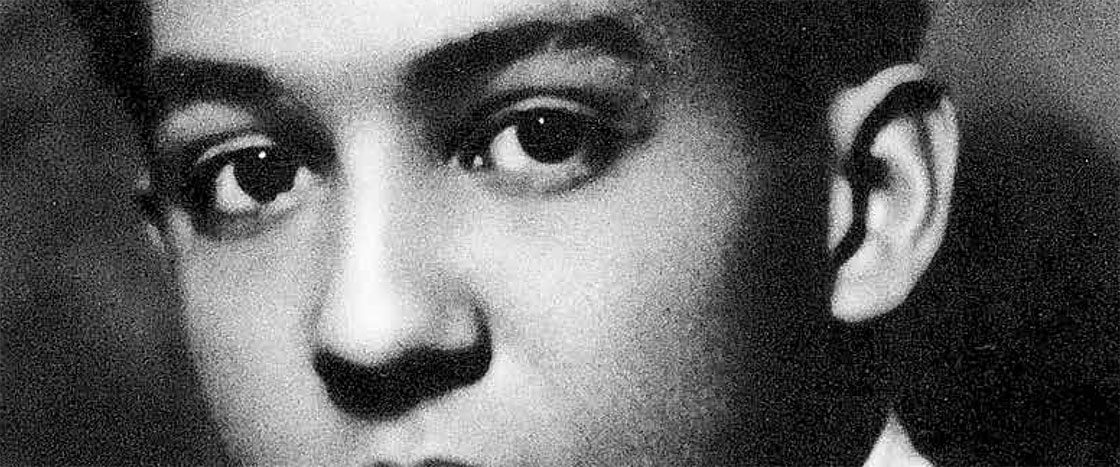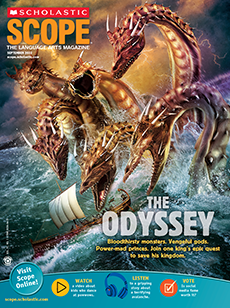- Read aloud the “As You Read” box on page 16. Make sure students understand that the lines from the poems appear in italicized text.
- Assign parts and read the play.
- Discuss the following questions as a class:
Close-Reading Questions
- Why might Kristin Lewis have chosen to open Scene 1 with the line of poetry that she did? (text structure) Lewis may have chosen to use these lines of poetry to introduce the idea of loneliness, which Langston experiences in the scene when he recalls white kids calling him names and when kids at school make fun of him for wearing cast-off shoes.
- In the lines of poetry at the beginning of Scene 2, what does the speaker mean when he says that a “fenced-off narrow space” is assigned to him? How is this idea reflected in Scene 2 and in the photos and captions throughout the play? (figurative language, text structure, text features) The speaker—who we can infer is black from his mention of having a “black face”—means that as a black person in America, his opportunities are limited. This idea is reflected in Scene 2 when Langston is banned from his favorite movie house, the Children’s Day party, and from competing in school track meets. The photo and caption on page 18, which show an example of a “White Only” sign in the segregated South, also reflect the idea in the poem.
- How does the question asked in the lines of poetry at the beginning of Scene 4 relate to what happens in the scene? (Note that deferred means “put off or delayed to a later time.”) (key ideas, text structure) In this scene, Langston is “overcome with uncertainty,” and his dream of moving to Harlem and becoming a poet seems “impossibly far away.” The poetry asks if a dream put off until later will fade away; in the scene, Langston seems to be struggling to keep hold of his dream.
- In Scene 4, what does Langston mean when he tells Sartur, “I’ll turn my poems into bread”? (figurative language) Langston means he’ll sell his poems. He uses “bread” to mean “money.”
- Scene 6 ends with Langston smiling and saying, “I’m going back to Harlem.” Why is returning to Harlem so important for Langston? (inference) Throughout his early life, Langston felt like an outsider and struggled to find a place where he belonged. You can infer that he now feels like he has something substantial to contribute to the Harlem Renaissance— and that he will finally be where he belongs.
- What traits helped Langston succeed? (character) Students might say that Langston succeeded because of his courage, resilience, and sense of adventure.
Divide students into three groups. Assign Scene 3 to one group, Scene 5 to another, and Scene 6 to the third. Each group should analyze, in its assigned scene, the connection between the poetry and what happens in the scene. (Students have practiced doing this for the other scenes through the close-reading questions.)
Have each group share its conclusions with the class.
Critical-Thinking Questions
- Throughout his early life, Langston repeatedly finds himself an outsider. How might this have influenced his work as a poet? Perhaps being an outsider made Langston a more prolific writer; being barred from activities like the Children’s Day party may have driven him to express his feelings in writing. His feelings of being an outsider certainly affected the content of his work: The poetry included in this play describes loneliness, frustration, and dreams about a better future.
- Langston wrote several poems about dreams. Why might this have been a particularly powerful topic for African-Americans in the 1920s and 1930s? Poems about dreams may have offered African- Americans hope and a reason to persevere in a time when they really needed it: During the 1920s and ‘30s, African-Americans faced incredible social, political, and economic challenges.
- How do the lines of poetry in the play add to your understanding of the story? How would the play be different without them? The poetry offers a look into Langston’s mind and heart; it offers a description of Langston’s feelings in his own words. The poetry adds authenticity to the play and leaves the impression that Langston has co-authored this biography.


